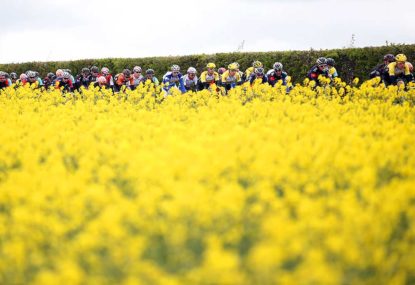'I've just won a stage of the Tour de France, mate!': Hindley grabs yellow jersey as Aussie blows Tour apart
Australia's Jai Hindley has said he is "lost for words" after a shock stage victory at the Tour de France earned him the leader's…

Just like the 2013 Giro d’Italia, Giro 2017 will again be remembered for some Italian cyclists disgracing a major cycling event in their own backyard.
Less than 24 hours before the start of the Giro in Alghero, Sardinia, and just after the Bardiani-CSF team was paraded to the Italian tifosi at the official presentation, the UCI released a statement naming Nicola Ruffoni and Stefano Pirazzi from Bardiani-CSF as having returned positive samples in out-of-competition tests for GH-releasing peptides.
This was not the first time that cyclists from an Italian team have brought shame on RCS Sport, the organisers of the Giro. During the 2013 edition, Mauro Santambrogio and Danilo Di Luca both tested positive for EPO.
Neither Ruffoni nor Pirazzi are new on the professional cycling circuit. They knew the risks of being caught in out-of-competition tests and that a positive test would result in them being ostracised by their fellow professional cyclists. If they return positive B samples, they will be fired by their team and will risk suspensions of up to two years.
Bardiani-CSF is only a small Italian pro-continental team that needs a wildcard invitation to participate in the Giro and other World Tour events. These doping violations risk the whole team being kicked out of the Giro because of the stupidity of two riders.
RCS Sport released a sternly written press release on Thursday night stating that it “reserves the right to take any appropriate measure to protect the image and the name of the Giro d’Italia”.
Fortunately for the team, the organisers have not thrown them out of the Giro at this stage, but Bardiani-CSF face a 15 to 45-day suspension for having two doping positives in a 12-month period under the UCI rules.
Ruffoni and Pirazzi are not the first Italian riders to have returned adverse analytical findings of banned substances; there has been a raft of Italian riders caught up in doping scandals – before them there were Danilo Di Luca, Matteo Rabottini, Stefano Garzelli, Diego Ulissi, Davide Appollonio, Luca Paolini, Alessandro Ballan, Ivan Basso and Riccardo Ricco, just to name a few. Many of these cyclists have worn the maglia rosa or won stages of the Giro or other significant races.
In fact, Italian cyclists have been some of the worst doping offenders in modern day cycling.
Significant doping offences have broader ramifications for cycling teams beyond just firing offending cyclists. After Matteo Rabottini became the third Farnese Vini Neri-Sottoli rider to fail a doping test in just over 12 months in 2014 it left the team teetering on the edge of collapse when the main sponsors withdrew their support.
After nearly collapsing, the team changed its name to Team Southeast and survived on the smell of an oily rag until securing additional sponsors and changing its name to Wilier Triestina–Selle Italia. If it collapsed, it would have left riders unpaid and looking for new employment mid-season.
Bardiani-CSF Directeur sportif Bruno Reverberi has advised media that all major sponsors are standing by the team after the doping news – in fact their two main sponsors, Bardiani Valvole and CSF Inox, issued a joint press release expressing unequivocal support for team management on the team’s webpage soon after.
It is a positive outcome for the team and the sport more generally that its sponsors are prepared to work with team management “to increase public awareness about sport as a body pure and spirit activity”.
Velonews.com published an article on 28 April 2017 entitled ‘Is Italian cycling sinking?‘ that examined reasons behind the lack of Italian cycling teams in the peloton. It stated, “In the early 2000s, when it boasted four major, top-level teams and six more second-tier teams. Since then, Italy has seen its major cycling teams slowly die off. The shuttering of Lampre-Merida was a shock to many.”
It suggested that Italy’s long-running economic crisis was the reason behind companies pulling out of cycling.
While the economic crisis and dwindling sponsorships budgets are likely to be the main culprit, the continuing shame from Italian cyclists doping and the negativity of being associated with a sport that still suffers from doping is also likely to be a significant factor behind companies directing their sponsorships budgets to other sports. Businesses need to protect their image, and that means being associated with sports that have a cleaner and healthier image.
After the Lance Armstrong doping scandal companies, event organisers and cyclists do not want to be caught up in the negativity with doping – and who could blame them?
Cycling’s governing body has done a lot to stamp out the practice, but there is still a long way to go.
Failed doping tests have wide consequences on a large number of parties than just the riders themselves. It also affects the credibility of the sport and the clean athletes.
Unfortunately, the latest doping indiscretion on the eve of the Giro again involved Italian cyclists. The Italian authorities need to do more and be more proactive in stamping out doping before the performance of all clean Italian cyclists begin to be seen as suspicious.
Trust, once lost, will be hard to earn back.